Principles & Practice of Management Accounting Report - Alpha Limited
VerifiedAdded on 2023/01/13
|23
|5287
|91
Report
AI Summary
This report provides a comprehensive analysis of management accounting principles and practices, focusing on the context of Alpha Limited, a medium-sized manufacturing enterprise. It covers key aspects such as management accounting systems, including inventory management, cost accounting, price optimization, and job costing. The report delves into different methods of management accounting reporting, including inventory reports, performance reports, accounts receivable reports, and budget reports. It further explores the calculation of costs using marginal and absorption costing methods, along with their respective profit and loss accounts. Additionally, the report examines the advantages and disadvantages of various planning tools of budgetary control and discusses the adaptation of management accounting to respond to financial problems. The analysis aims to provide a clear understanding of the application of management accounting techniques for effective financial management and decision-making within a business context.

Principles & Practice of
Management
Accounting
Management
Accounting
Paraphrase This Document
Need a fresh take? Get an instant paraphrase of this document with our AI Paraphraser

Table of Contents
INTRODUCTION...........................................................................................................................3
TASK...............................................................................................................................................3
P1. Management Accounting and its systems:.......................................................................3
M1 Benefits of management Accounting systems:................................................................5
P2. Different methods of management accounting reporting:................................................6
TASK 2............................................................................................................................................7
P3. Calculation of costs on the basis of marginal and absorption costing method:...............7
M2. Effectively apply a variety of MA techniques and generate correct financial reports: 14
P4. Explanation of advantages and disadvantages of different types of planning tools of
budgetary control:.................................................................................................................15
P5 Adaption of management according to respond financial problem................................17
CONCLUSION..............................................................................................................................21
REFERENCES..............................................................................................................................22
INTRODUCTION...........................................................................................................................3
TASK...............................................................................................................................................3
P1. Management Accounting and its systems:.......................................................................3
M1 Benefits of management Accounting systems:................................................................5
P2. Different methods of management accounting reporting:................................................6
TASK 2............................................................................................................................................7
P3. Calculation of costs on the basis of marginal and absorption costing method:...............7
M2. Effectively apply a variety of MA techniques and generate correct financial reports: 14
P4. Explanation of advantages and disadvantages of different types of planning tools of
budgetary control:.................................................................................................................15
P5 Adaption of management according to respond financial problem................................17
CONCLUSION..............................................................................................................................21
REFERENCES..............................................................................................................................22
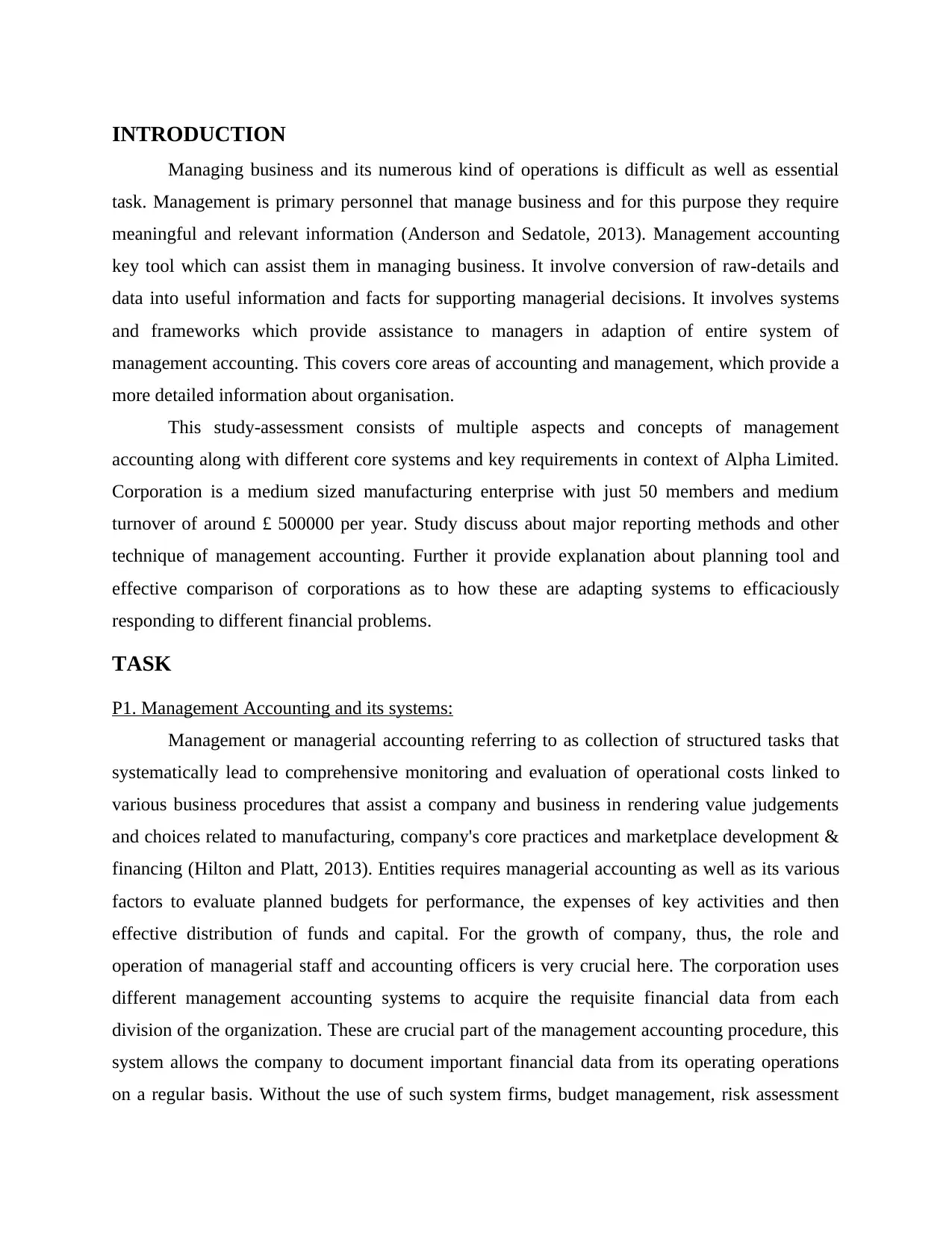
INTRODUCTION
Managing business and its numerous kind of operations is difficult as well as essential
task. Management is primary personnel that manage business and for this purpose they require
meaningful and relevant information (Anderson and Sedatole, 2013). Management accounting
key tool which can assist them in managing business. It involve conversion of raw-details and
data into useful information and facts for supporting managerial decisions. It involves systems
and frameworks which provide assistance to managers in adaption of entire system of
management accounting. This covers core areas of accounting and management, which provide a
more detailed information about organisation.
This study-assessment consists of multiple aspects and concepts of management
accounting along with different core systems and key requirements in context of Alpha Limited.
Corporation is a medium sized manufacturing enterprise with just 50 members and medium
turnover of around £ 500000 per year. Study discuss about major reporting methods and other
technique of management accounting. Further it provide explanation about planning tool and
effective comparison of corporations as to how these are adapting systems to efficaciously
responding to different financial problems.
TASK
P1. Management Accounting and its systems:
Management or managerial accounting referring to as collection of structured tasks that
systematically lead to comprehensive monitoring and evaluation of operational costs linked to
various business procedures that assist a company and business in rendering value judgements
and choices related to manufacturing, company's core practices and marketplace development &
financing (Hilton and Platt, 2013). Entities requires managerial accounting as well as its various
factors to evaluate planned budgets for performance, the expenses of key activities and then
effective distribution of funds and capital. For the growth of company, thus, the role and
operation of managerial staff and accounting officers is very crucial here. The corporation uses
different management accounting systems to acquire the requisite financial data from each
division of the organization. These are crucial part of the management accounting procedure, this
system allows the company to document important financial data from its operating operations
on a regular basis. Without the use of such system firms, budget management, risk assessment
Managing business and its numerous kind of operations is difficult as well as essential
task. Management is primary personnel that manage business and for this purpose they require
meaningful and relevant information (Anderson and Sedatole, 2013). Management accounting
key tool which can assist them in managing business. It involve conversion of raw-details and
data into useful information and facts for supporting managerial decisions. It involves systems
and frameworks which provide assistance to managers in adaption of entire system of
management accounting. This covers core areas of accounting and management, which provide a
more detailed information about organisation.
This study-assessment consists of multiple aspects and concepts of management
accounting along with different core systems and key requirements in context of Alpha Limited.
Corporation is a medium sized manufacturing enterprise with just 50 members and medium
turnover of around £ 500000 per year. Study discuss about major reporting methods and other
technique of management accounting. Further it provide explanation about planning tool and
effective comparison of corporations as to how these are adapting systems to efficaciously
responding to different financial problems.
TASK
P1. Management Accounting and its systems:
Management or managerial accounting referring to as collection of structured tasks that
systematically lead to comprehensive monitoring and evaluation of operational costs linked to
various business procedures that assist a company and business in rendering value judgements
and choices related to manufacturing, company's core practices and marketplace development &
financing (Hilton and Platt, 2013). Entities requires managerial accounting as well as its various
factors to evaluate planned budgets for performance, the expenses of key activities and then
effective distribution of funds and capital. For the growth of company, thus, the role and
operation of managerial staff and accounting officers is very crucial here. The corporation uses
different management accounting systems to acquire the requisite financial data from each
division of the organization. These are crucial part of the management accounting procedure, this
system allows the company to document important financial data from its operating operations
on a regular basis. Without the use of such system firms, budget management, risk assessment
⊘ This is a preview!⊘
Do you want full access?
Subscribe today to unlock all pages.

Trusted by 1+ million students worldwide
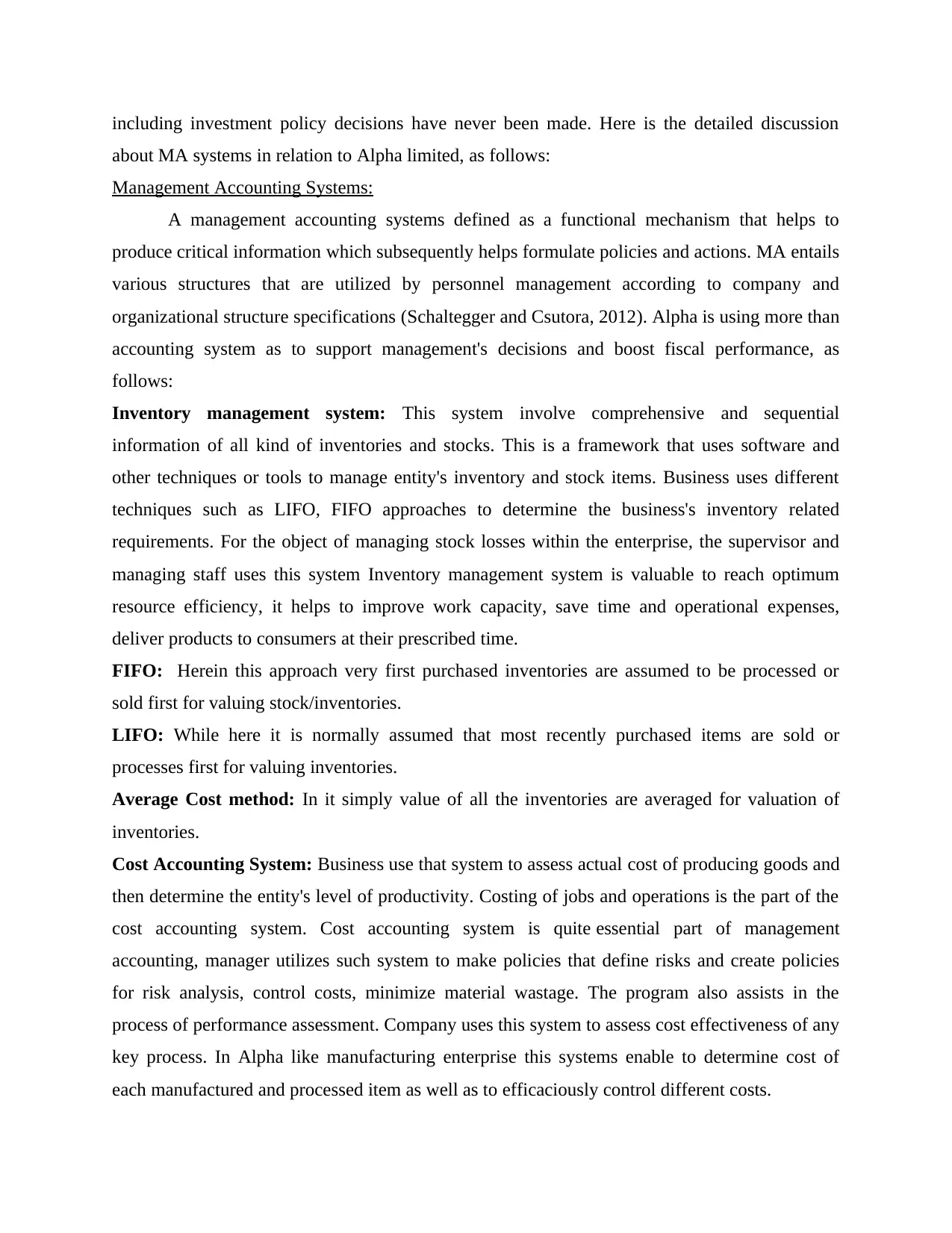
including investment policy decisions have never been made. Here is the detailed discussion
about MA systems in relation to Alpha limited, as follows:
Management Accounting Systems:
A management accounting systems defined as a functional mechanism that helps to
produce critical information which subsequently helps formulate policies and actions. MA entails
various structures that are utilized by personnel management according to company and
organizational structure specifications (Schaltegger and Csutora, 2012). Alpha is using more than
accounting system as to support management's decisions and boost fiscal performance, as
follows:
Inventory management system: This system involve comprehensive and sequential
information of all kind of inventories and stocks. This is a framework that uses software and
other techniques or tools to manage entity's inventory and stock items. Business uses different
techniques such as LIFO, FIFO approaches to determine the business's inventory related
requirements. For the object of managing stock losses within the enterprise, the supervisor and
managing staff uses this system Inventory management system is valuable to reach optimum
resource efficiency, it helps to improve work capacity, save time and operational expenses,
deliver products to consumers at their prescribed time.
FIFO: Herein this approach very first purchased inventories are assumed to be processed or
sold first for valuing stock/inventories.
LIFO: While here it is normally assumed that most recently purchased items are sold or
processes first for valuing inventories.
Average Cost method: In it simply value of all the inventories are averaged for valuation of
inventories.
Cost Accounting System: Business use that system to assess actual cost of producing goods and
then determine the entity's level of productivity. Costing of jobs and operations is the part of the
cost accounting system. Cost accounting system is quite essential part of management
accounting, manager utilizes such system to make policies that define risks and create policies
for risk analysis, control costs, minimize material wastage. The program also assists in the
process of performance assessment. Company uses this system to assess cost effectiveness of any
key process. In Alpha like manufacturing enterprise this systems enable to determine cost of
each manufactured and processed item as well as to efficaciously control different costs.
about MA systems in relation to Alpha limited, as follows:
Management Accounting Systems:
A management accounting systems defined as a functional mechanism that helps to
produce critical information which subsequently helps formulate policies and actions. MA entails
various structures that are utilized by personnel management according to company and
organizational structure specifications (Schaltegger and Csutora, 2012). Alpha is using more than
accounting system as to support management's decisions and boost fiscal performance, as
follows:
Inventory management system: This system involve comprehensive and sequential
information of all kind of inventories and stocks. This is a framework that uses software and
other techniques or tools to manage entity's inventory and stock items. Business uses different
techniques such as LIFO, FIFO approaches to determine the business's inventory related
requirements. For the object of managing stock losses within the enterprise, the supervisor and
managing staff uses this system Inventory management system is valuable to reach optimum
resource efficiency, it helps to improve work capacity, save time and operational expenses,
deliver products to consumers at their prescribed time.
FIFO: Herein this approach very first purchased inventories are assumed to be processed or
sold first for valuing stock/inventories.
LIFO: While here it is normally assumed that most recently purchased items are sold or
processes first for valuing inventories.
Average Cost method: In it simply value of all the inventories are averaged for valuation of
inventories.
Cost Accounting System: Business use that system to assess actual cost of producing goods and
then determine the entity's level of productivity. Costing of jobs and operations is the part of the
cost accounting system. Cost accounting system is quite essential part of management
accounting, manager utilizes such system to make policies that define risks and create policies
for risk analysis, control costs, minimize material wastage. The program also assists in the
process of performance assessment. Company uses this system to assess cost effectiveness of any
key process. In Alpha like manufacturing enterprise this systems enable to determine cost of
each manufactured and processed item as well as to efficaciously control different costs.
Paraphrase This Document
Need a fresh take? Get an instant paraphrase of this document with our AI Paraphraser

Price optimization system
Price optimization system is the system that uses the mathematical analysis for
determining the price of a product the customers will be willing to pay. It is also used in
determine prices which meet the maximum operating profit for the company (Talley, 2017).
There are many software used by the companies to handle the complex required calculations for
price and cost. Such programs are mathematical program that enables a company to know about
the level of demand incur at different price levels. The data used in price optimization can
includes operating cost, historic prices and sales volume reports, survey data, and inventories.
Job costing system:
This system classify different processes in specific tasks and list all the costs related such
jobs as to assess the cost of job. This system is used to assigning cost to each product of the
company and then calculate and measuring cost of each order company receive free their
customer. Company use this system when their products are identical. Company make products
according to the demand of their customers. This system of managerial accounting helps in
identifying market demand of customers and useful in making and implementing decision of the
company. In Alpha limited this system is used to recognise jobs which are critical for
organisation's performance.
M1 Benefits of management Accounting systems:
System Benefit
Inventories Management System This system is advantageous for Alpha limited
in controlling numerous inventories costs and
identify the root-cause of increasing
inventories costs.
Cost Accounting System In Aplha, managers can use this system to
minimise overall production and operating
cost. It also help in regulating different costs
and optimising operational costs.
Price-optimisation System Price-optimisation is beneficial for enterprise
to control and limit prices. This assist
managers in formulating pricing strategies and
Price optimization system is the system that uses the mathematical analysis for
determining the price of a product the customers will be willing to pay. It is also used in
determine prices which meet the maximum operating profit for the company (Talley, 2017).
There are many software used by the companies to handle the complex required calculations for
price and cost. Such programs are mathematical program that enables a company to know about
the level of demand incur at different price levels. The data used in price optimization can
includes operating cost, historic prices and sales volume reports, survey data, and inventories.
Job costing system:
This system classify different processes in specific tasks and list all the costs related such
jobs as to assess the cost of job. This system is used to assigning cost to each product of the
company and then calculate and measuring cost of each order company receive free their
customer. Company use this system when their products are identical. Company make products
according to the demand of their customers. This system of managerial accounting helps in
identifying market demand of customers and useful in making and implementing decision of the
company. In Alpha limited this system is used to recognise jobs which are critical for
organisation's performance.
M1 Benefits of management Accounting systems:
System Benefit
Inventories Management System This system is advantageous for Alpha limited
in controlling numerous inventories costs and
identify the root-cause of increasing
inventories costs.
Cost Accounting System In Aplha, managers can use this system to
minimise overall production and operating
cost. It also help in regulating different costs
and optimising operational costs.
Price-optimisation System Price-optimisation is beneficial for enterprise
to control and limit prices. This assist
managers in formulating pricing strategies and
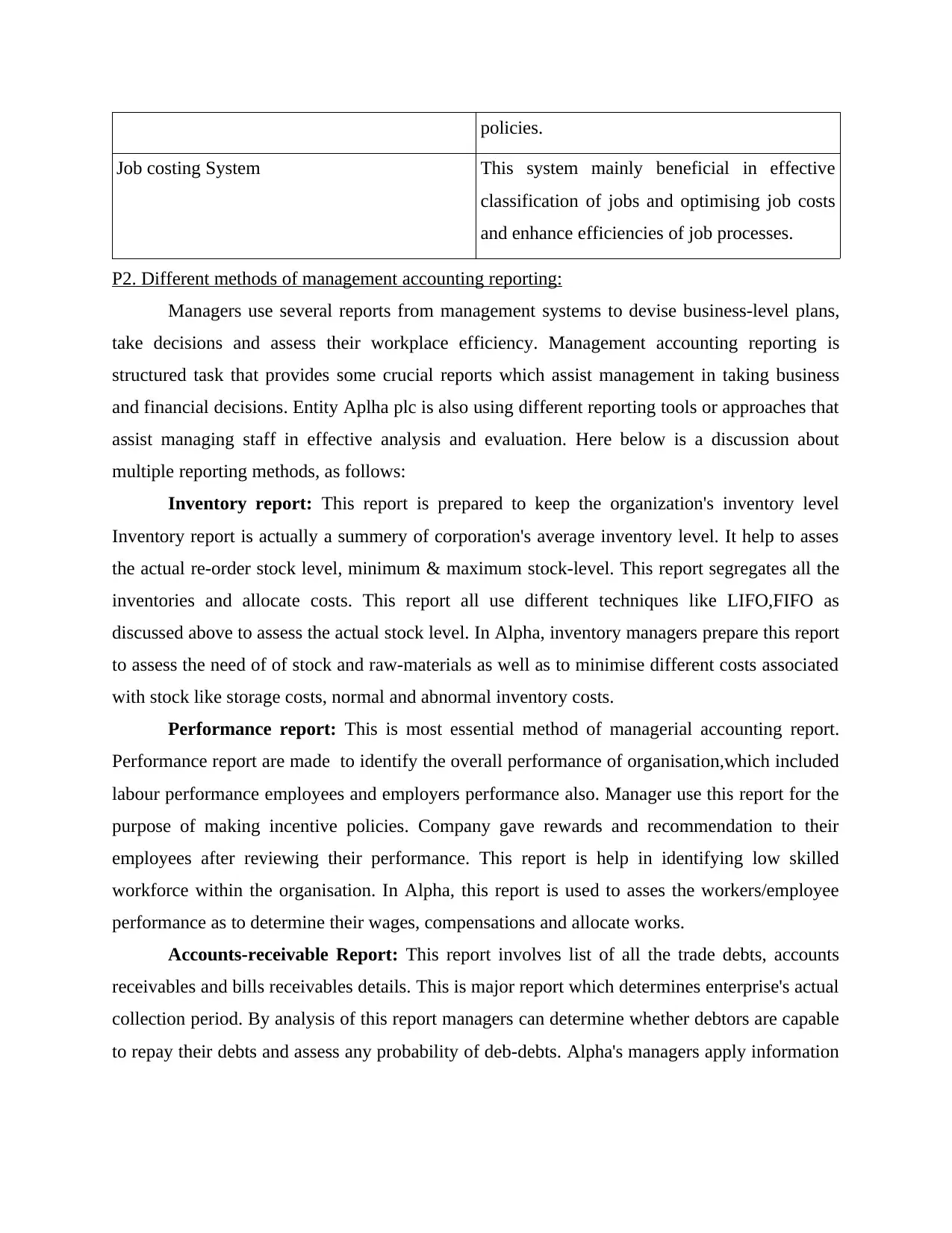
policies.
Job costing System This system mainly beneficial in effective
classification of jobs and optimising job costs
and enhance efficiencies of job processes.
P2. Different methods of management accounting reporting:
Managers use several reports from management systems to devise business-level plans,
take decisions and assess their workplace efficiency. Management accounting reporting is
structured task that provides some crucial reports which assist management in taking business
and financial decisions. Entity Aplha plc is also using different reporting tools or approaches that
assist managing staff in effective analysis and evaluation. Here below is a discussion about
multiple reporting methods, as follows:
Inventory report: This report is prepared to keep the organization's inventory level
Inventory report is actually a summery of corporation's average inventory level. It help to asses
the actual re-order stock level, minimum & maximum stock-level. This report segregates all the
inventories and allocate costs. This report all use different techniques like LIFO,FIFO as
discussed above to assess the actual stock level. In Alpha, inventory managers prepare this report
to assess the need of of stock and raw-materials as well as to minimise different costs associated
with stock like storage costs, normal and abnormal inventory costs.
Performance report: This is most essential method of managerial accounting report.
Performance report are made to identify the overall performance of organisation,which included
labour performance employees and employers performance also. Manager use this report for the
purpose of making incentive policies. Company gave rewards and recommendation to their
employees after reviewing their performance. This report is help in identifying low skilled
workforce within the organisation. In Alpha, this report is used to asses the workers/employee
performance as to determine their wages, compensations and allocate works.
Accounts-receivable Report: This report involves list of all the trade debts, accounts
receivables and bills receivables details. This is major report which determines enterprise's actual
collection period. By analysis of this report managers can determine whether debtors are capable
to repay their debts and assess any probability of deb-debts. Alpha's managers apply information
Job costing System This system mainly beneficial in effective
classification of jobs and optimising job costs
and enhance efficiencies of job processes.
P2. Different methods of management accounting reporting:
Managers use several reports from management systems to devise business-level plans,
take decisions and assess their workplace efficiency. Management accounting reporting is
structured task that provides some crucial reports which assist management in taking business
and financial decisions. Entity Aplha plc is also using different reporting tools or approaches that
assist managing staff in effective analysis and evaluation. Here below is a discussion about
multiple reporting methods, as follows:
Inventory report: This report is prepared to keep the organization's inventory level
Inventory report is actually a summery of corporation's average inventory level. It help to asses
the actual re-order stock level, minimum & maximum stock-level. This report segregates all the
inventories and allocate costs. This report all use different techniques like LIFO,FIFO as
discussed above to assess the actual stock level. In Alpha, inventory managers prepare this report
to assess the need of of stock and raw-materials as well as to minimise different costs associated
with stock like storage costs, normal and abnormal inventory costs.
Performance report: This is most essential method of managerial accounting report.
Performance report are made to identify the overall performance of organisation,which included
labour performance employees and employers performance also. Manager use this report for the
purpose of making incentive policies. Company gave rewards and recommendation to their
employees after reviewing their performance. This report is help in identifying low skilled
workforce within the organisation. In Alpha, this report is used to asses the workers/employee
performance as to determine their wages, compensations and allocate works.
Accounts-receivable Report: This report involves list of all the trade debts, accounts
receivables and bills receivables details. This is major report which determines enterprise's actual
collection period. By analysis of this report managers can determine whether debtors are capable
to repay their debts and assess any probability of deb-debts. Alpha's managers apply information
⊘ This is a preview!⊘
Do you want full access?
Subscribe today to unlock all pages.

Trusted by 1+ million students worldwide

of this report to determine the credit policy in relation to debtors. This allow managerial staff to
manage cash-flows by enhancing cash collections.
Budget reports: In this method organisation use to built budget reports in order to
analysis their workforce performance (Fisher and Krumwiede, 2012). Budget report is based on
the collection of provisos data. In this method managers set a target which must be fulfilled in
prescribe time limit. After that managers identifying differences of set target and achieve target
and then make policies to reduce the gap of current and budget target. In Alpha management
apply this approach to assess the actual performance status in different areas by analysis of
variations. This is most critical report which defines the actual efficiency level.
D1. Integration of MA-systems within organisation:
Core function of managerial accounting is to provide critical and meaningful information
for management's decision making tasks, which make it necessary to integrate MA systems
within enterprise. Since lack of integration lead to barrier in generation of such information and
eventually affects decision making. In an enterprise such as Alpha Limited, financial and
accounting reporting functions and processes provide relevant information that is utilized in
more than one MA-systems, thus requiring formal integration for rapid information generation.
TASK 2
P3. Calculation of costs on the basis of marginal and absorption costing method:
Marginal costing: Marginal costs reflect additional costs generated when incremental units are
generated. It is determined by considering the overall increase in cost of producing additional
goods, as well as dividing this by changing number of goods manufactured. Under marginal
costing, marginal cost is measured to assess the actual profitability level.
Absorption Costing: The phrase "absorption costing" relates to the mechanism by which all the
expenses relating to production process are applied and then assigned separately to the goods.
This costing approach is important as per accounting standards to generate a stock value that is
recorded in an organisation's balance sheet.
Absorption costing:
(a) Cost card
Cost card (Absorption costing)
manage cash-flows by enhancing cash collections.
Budget reports: In this method organisation use to built budget reports in order to
analysis their workforce performance (Fisher and Krumwiede, 2012). Budget report is based on
the collection of provisos data. In this method managers set a target which must be fulfilled in
prescribe time limit. After that managers identifying differences of set target and achieve target
and then make policies to reduce the gap of current and budget target. In Alpha management
apply this approach to assess the actual performance status in different areas by analysis of
variations. This is most critical report which defines the actual efficiency level.
D1. Integration of MA-systems within organisation:
Core function of managerial accounting is to provide critical and meaningful information
for management's decision making tasks, which make it necessary to integrate MA systems
within enterprise. Since lack of integration lead to barrier in generation of such information and
eventually affects decision making. In an enterprise such as Alpha Limited, financial and
accounting reporting functions and processes provide relevant information that is utilized in
more than one MA-systems, thus requiring formal integration for rapid information generation.
TASK 2
P3. Calculation of costs on the basis of marginal and absorption costing method:
Marginal costing: Marginal costs reflect additional costs generated when incremental units are
generated. It is determined by considering the overall increase in cost of producing additional
goods, as well as dividing this by changing number of goods manufactured. Under marginal
costing, marginal cost is measured to assess the actual profitability level.
Absorption Costing: The phrase "absorption costing" relates to the mechanism by which all the
expenses relating to production process are applied and then assigned separately to the goods.
This costing approach is important as per accounting standards to generate a stock value that is
recorded in an organisation's balance sheet.
Absorption costing:
(a) Cost card
Cost card (Absorption costing)
Paraphrase This Document
Need a fresh take? Get an instant paraphrase of this document with our AI Paraphraser
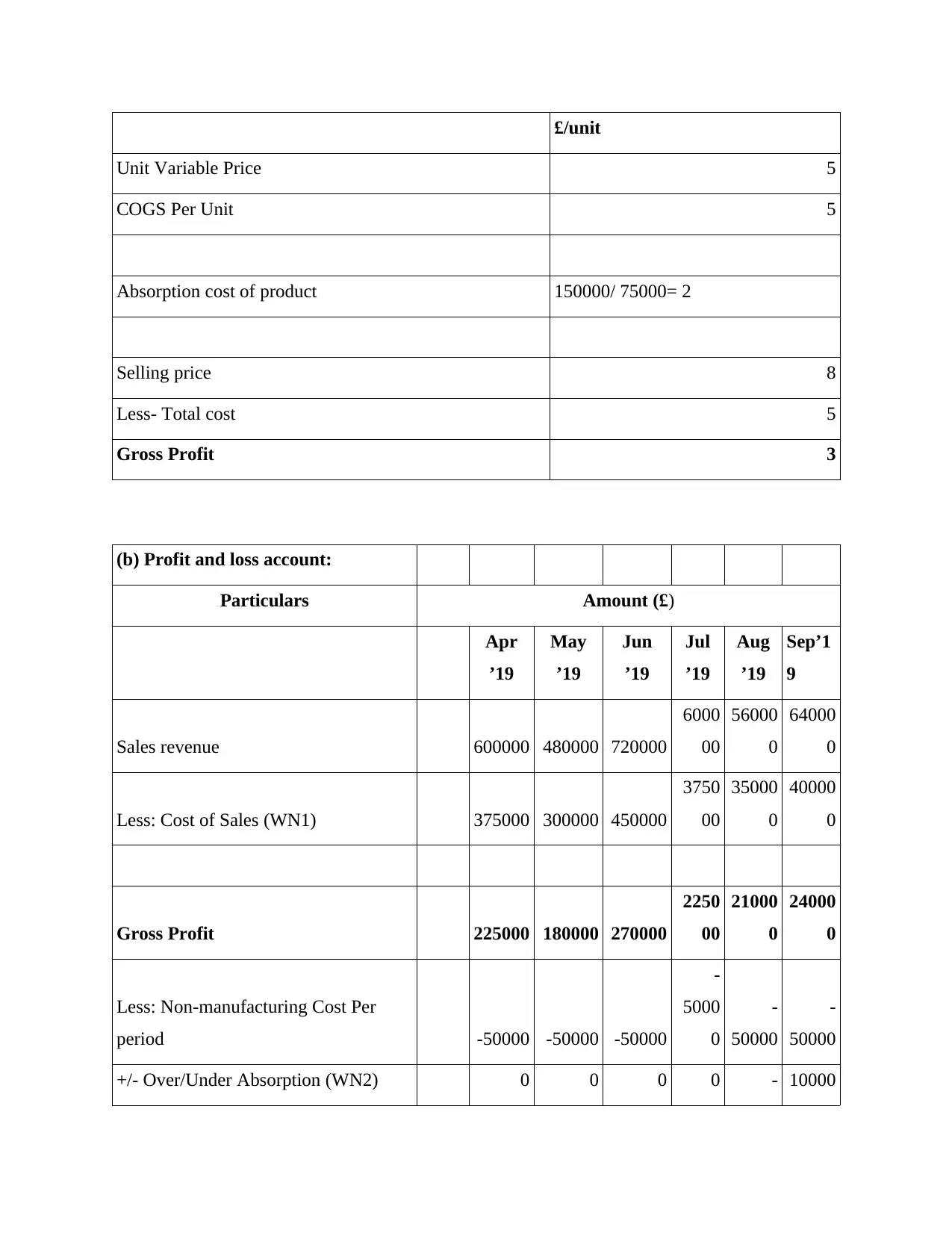
£/unit
Unit Variable Price 5
COGS Per Unit 5
Absorption cost of product 150000/ 75000= 2
Selling price 8
Less- Total cost 5
Gross Profit 3
(b) Profit and loss account:
Particulars Amount (£)
Apr
’19
May
’19
Jun
’19
Jul
’19
Aug
’19
Sep’1
9
Sales revenue 600000 480000 720000
6000
00
56000
0
64000
0
Less: Cost of Sales (WN1) 375000 300000 450000
3750
00
35000
0
40000
0
Gross Profit 225000 180000 270000
2250
00
21000
0
24000
0
Less: Non-manufacturing Cost Per
period -50000 -50000 -50000
-
5000
0
-
50000
-
50000
+/- Over/Under Absorption (WN2) 0 0 0 0 - 10000
Unit Variable Price 5
COGS Per Unit 5
Absorption cost of product 150000/ 75000= 2
Selling price 8
Less- Total cost 5
Gross Profit 3
(b) Profit and loss account:
Particulars Amount (£)
Apr
’19
May
’19
Jun
’19
Jul
’19
Aug
’19
Sep’1
9
Sales revenue 600000 480000 720000
6000
00
56000
0
64000
0
Less: Cost of Sales (WN1) 375000 300000 450000
3750
00
35000
0
40000
0
Gross Profit 225000 180000 270000
2250
00
21000
0
24000
0
Less: Non-manufacturing Cost Per
period -50000 -50000 -50000
-
5000
0
-
50000
-
50000
+/- Over/Under Absorption (WN2) 0 0 0 0 - 10000

20000
Net Profit/Loss 175000 130000 220000
1750
00
14000
0
20000
0
WNI
Calculation of Variable cost
Apr
’19
May
’19
Jun
’19
Jul
’19
Aug
’19
Sep’1
9
Opening stock 0 0 75000 0 0 75000
Production cost 375000 375000 375000
3750
00
42500
0
35000
0
Less closing stock 0 -75000 0 0
-
75000
-
25000
375000 300000 450000
3750
00
35000
0
40000
0
WN2
Calculation of Over absorption/ Under absorption
Apr
’19
May
’19 Jun ’19
Jul
’19
Aug
’19
Sep’1
9
Fixed Production Overhead with budgeted
production 150000
15000
0 150000
15000
0
15000
0
15000
0
Fixed Production Overhead with actual
production
-
150000
-
15000
0 -150000
-
15000
0
-
17000
0
-
14000
0
Over/ Under absorption 0 0 0 0
-
20000 10000
Net Profit/Loss 175000 130000 220000
1750
00
14000
0
20000
0
WNI
Calculation of Variable cost
Apr
’19
May
’19
Jun
’19
Jul
’19
Aug
’19
Sep’1
9
Opening stock 0 0 75000 0 0 75000
Production cost 375000 375000 375000
3750
00
42500
0
35000
0
Less closing stock 0 -75000 0 0
-
75000
-
25000
375000 300000 450000
3750
00
35000
0
40000
0
WN2
Calculation of Over absorption/ Under absorption
Apr
’19
May
’19 Jun ’19
Jul
’19
Aug
’19
Sep’1
9
Fixed Production Overhead with budgeted
production 150000
15000
0 150000
15000
0
15000
0
15000
0
Fixed Production Overhead with actual
production
-
150000
-
15000
0 -150000
-
15000
0
-
17000
0
-
14000
0
Over/ Under absorption 0 0 0 0
-
20000 10000
⊘ This is a preview!⊘
Do you want full access?
Subscribe today to unlock all pages.

Trusted by 1+ million students worldwide

Marginal Costing:
(a) Cost card
Cost card (Marginal costing)
£/unit
Unit Variable Price 3
Marginal Cost 3
Selling price 8
Less- Marginal cost 3
Contribution 5
(b) Profit and loss account:
Particulars Amount (£)
Apr
’19
May
’19
Jun
’19 Jul ’19
Aug
’19 Sep’19
Sales revenue
60000
0
48000
0
72000
0
60000
0
56000
0
64000
0
Less: Variable cost
-
22500
0
-
18000
0
-
27000
0
-
22500
0
-
21000
0
-
24000
0
Contribution Margin
37500
0
30000
0
45000
0
37500
0
35000
0
40000
0
Less: Fixed Manufacturing Overheads
15000
0
15000
0
15000
0
15000
0
15000
0
15000
0
(a) Cost card
Cost card (Marginal costing)
£/unit
Unit Variable Price 3
Marginal Cost 3
Selling price 8
Less- Marginal cost 3
Contribution 5
(b) Profit and loss account:
Particulars Amount (£)
Apr
’19
May
’19
Jun
’19 Jul ’19
Aug
’19 Sep’19
Sales revenue
60000
0
48000
0
72000
0
60000
0
56000
0
64000
0
Less: Variable cost
-
22500
0
-
18000
0
-
27000
0
-
22500
0
-
21000
0
-
24000
0
Contribution Margin
37500
0
30000
0
45000
0
37500
0
35000
0
40000
0
Less: Fixed Manufacturing Overheads
15000
0
15000
0
15000
0
15000
0
15000
0
15000
0
Paraphrase This Document
Need a fresh take? Get an instant paraphrase of this document with our AI Paraphraser

Less: Non-manufacturing Cost Per
period 50000 50000 50000 50000 50000 50000
Net Profit/Loss
17500
0
10000
0
25000
0
17500
0
15000
0
20000
0
WN1
Calculation of Variable Cost
Variable cost
Apr
’19
May
’19
Jun
’19 Jul ’19
Aug
’19 Sep’19
Opening stock 0 45000 0 0 45000
Production cost
22500
0
22500
0
22500
0
22500
0
25500
0
21000
0
Less closing stock 0 -45000 0 0 -45000 -15000
22500
0
18000
0
27000
0
22500
0
21000
0
24000
0
Reconciliation of Net Income under Absorption and Marginal Costing
Apr ’19 May ’19 Jun ’19 Jul ’19 Aug ’19 Sep’19
Net Profit as per Absorption
Costing 175000 130000 220000 175000 140000 200000
+Changes in Opening Stock 0 0 30000 0 0 -30000
- Changes in Closing Stock 0 -30000 0 0 30000 20000
under and over absorption rate - - - - -20000 10000
period 50000 50000 50000 50000 50000 50000
Net Profit/Loss
17500
0
10000
0
25000
0
17500
0
15000
0
20000
0
WN1
Calculation of Variable Cost
Variable cost
Apr
’19
May
’19
Jun
’19 Jul ’19
Aug
’19 Sep’19
Opening stock 0 45000 0 0 45000
Production cost
22500
0
22500
0
22500
0
22500
0
25500
0
21000
0
Less closing stock 0 -45000 0 0 -45000 -15000
22500
0
18000
0
27000
0
22500
0
21000
0
24000
0
Reconciliation of Net Income under Absorption and Marginal Costing
Apr ’19 May ’19 Jun ’19 Jul ’19 Aug ’19 Sep’19
Net Profit as per Absorption
Costing 175000 130000 220000 175000 140000 200000
+Changes in Opening Stock 0 0 30000 0 0 -30000
- Changes in Closing Stock 0 -30000 0 0 30000 20000
under and over absorption rate - - - - -20000 10000
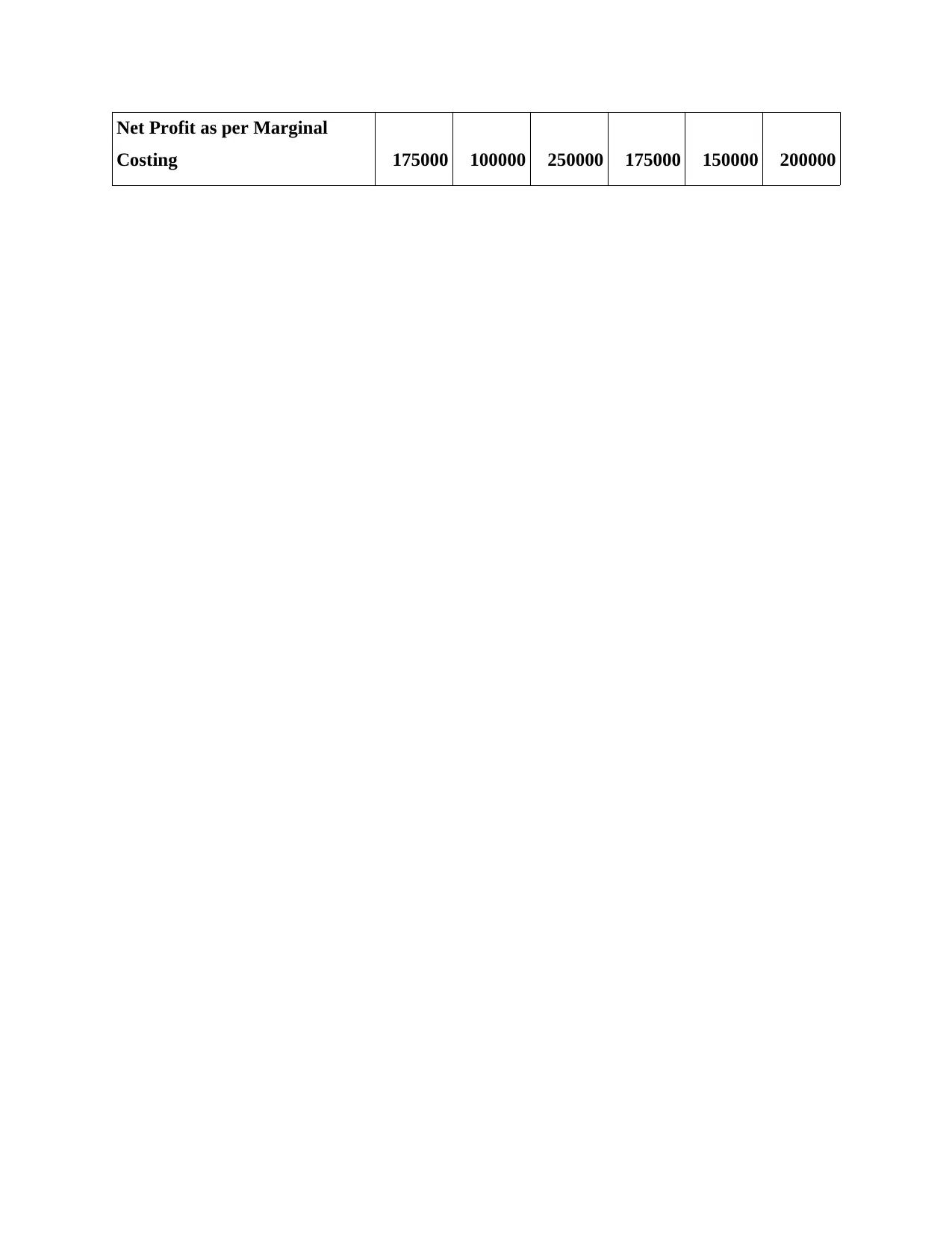
Net Profit as per Marginal
Costing 175000 100000 250000 175000 150000 200000
Costing 175000 100000 250000 175000 150000 200000
⊘ This is a preview!⊘
Do you want full access?
Subscribe today to unlock all pages.

Trusted by 1+ million students worldwide
1 out of 23
Related Documents
Your All-in-One AI-Powered Toolkit for Academic Success.
+13062052269
info@desklib.com
Available 24*7 on WhatsApp / Email
![[object Object]](/_next/static/media/star-bottom.7253800d.svg)
Unlock your academic potential
Copyright © 2020–2025 A2Z Services. All Rights Reserved. Developed and managed by ZUCOL.





